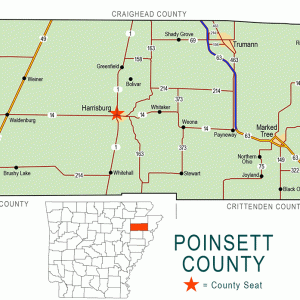calsfoundation@cals.org
Fisher (Poinsett County)
|
Latitude and Longitude: |
|
|
Elevation: |
233 feet |
|
Area: |
0.30 square miles (2020 Census) |
|
Population: |
180 (2020 Census) |
|
Incorporation Date: |
December 2, 1907 |
Historical Population as per the U.S. Census:
|
1810 |
1820 |
1830 |
1840 |
1850 |
1860 |
1870 |
1880 |
1890 |
1900 |
|
– |
– |
– |
– |
– |
– |
– |
– |
– |
– |
|
1910 |
1920 |
1930 |
1940 |
1950 |
1960 |
1970 |
1980 |
1990 |
2000 |
|
165 |
350 |
259 |
205 |
289 |
303 |
361 |
302 |
245 |
265 |
|
2010 |
2020 |
|
|
|
|
|
|
|
|
|
223 |
180 |
|
|
|
|
|
|
|
|
Fisher is located on U.S. Highway 49 in the southwest corner of Poinsett County. Like many other Arkansas cities, Fisher owes its existence to the railroad industry and the lumber industry.
In the nineteenth century, western Poinsett County was a flood-prone hardwood forest. A road connecting Helena (Phillips County) to Batesville (Independence County) ran across the future site of Fisher, but no families chose to live in the area until after the Civil War. Reportedly, the first building erected in what would be Fisher was a double-pen log cabin built by Allen Steelman in about 1875. Steelman’s son-in-law, Shep Pope, lived in the other half of the cabin. Local historians have written that, following the death of Steelman, his widow married Charley Kane, who in 1899 killed Shep Pope. This was the first recorded murder in western Poinsett County.
The Cotton Belt Railroad constructed a line across the region in 1883, making the harvest of oak, gum, and hickory trees possible. (After the timber was cleared from the area, rice became the predominant crop.) When the railroad engineers sought a location for a wood lot to fuel the steam locomotives, Steelman offered forty acres while the town of Waldenburg (Poinsett County) was still negotiating a fee for similar use of land. As a result, the railroad built a water tank and a depot on Steelman’s land. The depot’s paymaster was Bud Fisher, for whom the settlement was named. At first it was called Fisherville, but the name was later shortened. A post office was established in 1883. The first postmaster, E. H. Hare, also ran a general store, and his neighbors included physician Charles Newton and sawmill owner William Rain.
Land was acquired for a public school in 1889. By that time, Methodist evangelists were preaching in the area, although the first church building in the city was a Union church, used by several different congregations. Fisher was incorporated as a second-class city in 1907. Two years later, a tornado struck the city, leaving only one house undamaged. By 1912, the city had been rebuilt, including a new Methodist church and a brick schoolhouse. In 1913, a congregation of the Reorganized Church of Jesus Christ of Latter-Day Saints (now the Community of Christ) was established in Fisher. The schoolhouse was destroyed by fire in 1933 but was replaced in 1936. Also in 1936, a Baptist church was built, and a Church of Christ was soon established. For some years, the Church of Christ congregants shared their building with a Church of God congregation.
A Lions Club was started in Fisher in 1947. Governor Ben Laney was invited to speak at the opening meeting of the club. Reportedly, he made a wrong turn on his way into town and turned around in front of the house of the local bootlegger, who at first mistook the governor for a customer and attempted to make a sale.
Consolidation of the school districts of Fisher and Weiner (Poinsett County) began in 1949, with the high school classes combined in Weiner. In 1952, Fisher was again struck by a tornado, which destroyed four houses and the Church of Christ building. Both the Church of Christ and the Church of God built new church buildings in Fisher. Seventh- and eighth-grade classes were moved to Weiner in 1961, although grades first through sixth continued to be held in Fisher until 1971. After first through sixth grades were moved to Weiner, the empty school building in Fisher was rented to Frolic Footwear of Jonesboro (Craighead County), which used the building as a shoe factory until it was destroyed by fire in 1981. The company built a new factory in Fisher, though it was destroyed by a tornado in 1984. The post office in Fisher was also leveled by that tornado.
A volunteer fire department was organized in Fisher in 1967. Nine years later, the department received a fire truck as a gift from the Southern Pacific Transportation Company.
In the twenty-first century, Fisher is a residential community, with most employed citizens traveling twenty miles or more to their jobs in Jonesboro, Forrest City (St. Francis County), or Memphis, Tennessee. The population of Fisher in 2010 was 223—219 of whom were white. In 2014, the Arkansas Democrat-Gazette revealed that Fisher’s city council had not met since July 2012 and that the city, as a consequence, risked losing its incorporation.
For additional information:
Cherney, Elyssa. “With No Council, Fisher Could Lose Its Status as a City.” Arkansas Democrat-Gazette, July 14, 2014, pp. 1A, 6A.
Poinsett County, Arkansas, History and Families. Paducah, KY: Turner Publishing Company, 1998.
Steven Teske
Butler Center for Arkansas Studies
 Poinsett County Map
Poinsett County Map 




Comments
No comments on this entry yet.